Small White Flowering Trees (With Pictures): Identification Guide
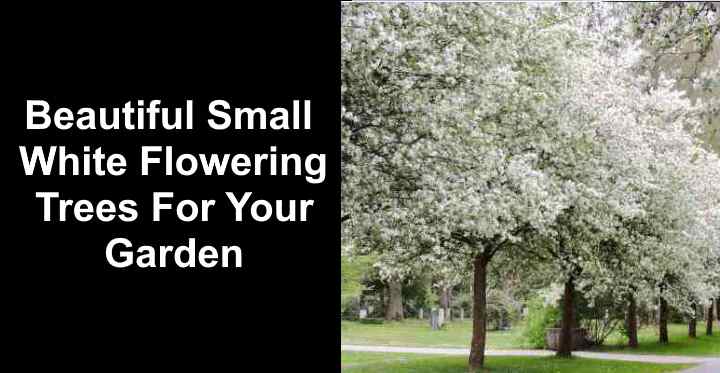
Small, white-flowering trees make a superb addition to compact garden landscaping. With their exquisite white blossoms, these trees can transform into enchanting centerpieces, adding an elegant touch to your outdoor environment.
Some of the best small white flowering trees to consider are the ornamental crabapple trees, known for breathtaking white blossoms during the blooming season. The tree hydrangea is another excellent option with its large, showy flower clusters. The flowering dogwood, with its iconic four-petaled white flowers, is also a beautiful tree that will enhance the appearance of your garden.
This article is a comprehensive guide to small white flowering trees. In this article you will find images, descriptions, and essential gardening information about the best small white flowering trees.
Small White Flowering Trees (With Pictures)
Below, you’ll find a selection of the best small white flowering trees suitable for planting in your garden:
Crabapple Trees (Malus)
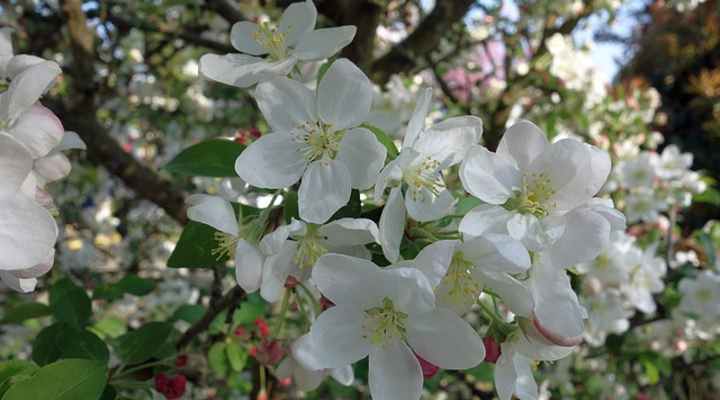
Crabapple trees are small decorative trees known for their stunning white to pink-colored flowers. In addition, these trees showcase glossy green, pointy oval leaves, along with small, berry-like apples with a tart flavor. The crabapple tree’s compact size makes them well suited for most small gardens, with the smallest ones not reaching more than 5 ft. (1.5 m) tall.
Crabapple trees have gained widespread popularity due to their ornamental value and cold hardiness. These trees thrive in USDA zones 3 – 8. The ideal spot for cultivating this low-maintenance tree is in a location with full sunlight and moderately fertile, well-draining soil.
While numerous crabapple varieties showcase white flowers, there are also smaller flowering crabapple trees that feature blossoms in hues such as red, orange, light pink, and deep purple.
Related reading: Discover the most beautiful types of crabapple trees
Mature Size: 5 – 15 ft. (1.5 – 4.5 m)
USDA Hardiness Zones: 3 – 8
Sun: Full sun
Tree Hydrangea (Hydrangea paniculata ‘Grandiflora’)
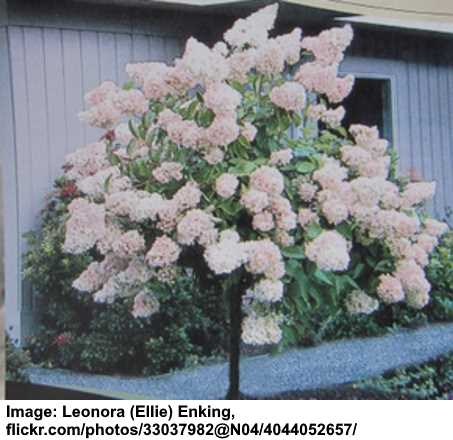
The tree hydrangea is a small, shrubby tree known for its beautiful, white conical flowers that bloom from summer through fall. The tree boasts a rounded canopy and dark green deciduous leaves that transform into a reddish-purple hue during autumn.
Reaching heights of up to 25 ft. (7.6 m), the tree hydrangea flourishes in USDA zones 3 – 8. This summer-flowering tree is heat-tolerant and performs best in well-drained soil. Tree hydrangeas are ideal for planting as hedges, serving as flowering privacy screens, or adding height and dimension to borders.
Mature Size: Up to 25 ft. (7.6 m)
USDA Hardiness Zones: 3 – 8
Sun: Full sun
Flowering Dogwood (Cornus)
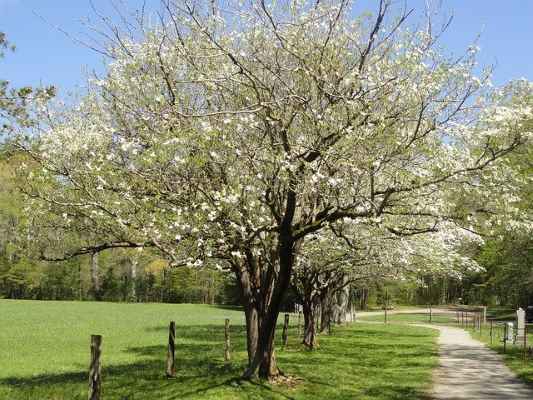
The flowering dogwood is a fast-growing tree known for its white, oval-shaped, four-petaled flowers. In the summer, the tree is covered with green, broad, pointed leaves that transition into a lovely reddish-purple in autumn. The tree also showcases clusters of red, berry-like fruits that appear in the fall. The flowering dogwood reaches heights of between 15 and 25 ft. (4.5 – 7.6 m).
White-flowering dogwood trees grow well in full sun to part shade in rich, well-drained soil. Plant this tree in USDA zones 3 to 8.
Related reading: How to identify the most common dogwood trees.
Mature Size: 15 – 25 ft. (4.5 – 7.6 m)
USDA Hardiness Zones: 3 – 8
Sun: Full sun to part shade
English Hawthorn (Crataegus laevigata)
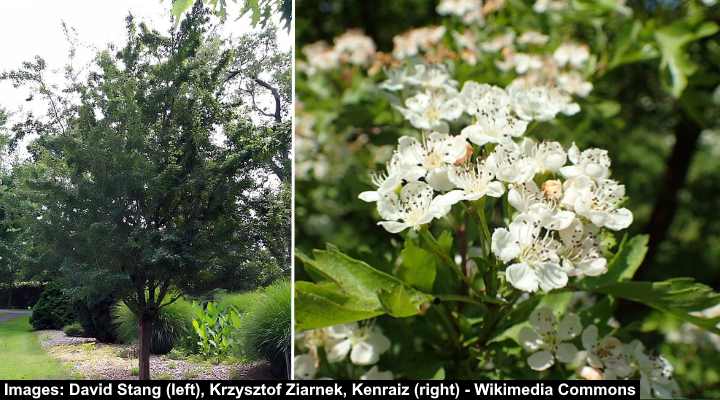
The English hawthorn is an attractive, small flowering tree recognized for its spring-blooming clusters of fragrant, creamy white flowers. These dainty blossoms feature small, oval petals and pale-yellow stamens. The vibrant white flowers contrast beautifully against the tree’s dark green foliage. Other identifying features of this tree are its large thorns, glossy green leaves, bright red fruits in the fall, and stiff branches that form unique zig-zag patterns.
English hawthorn trees grow best in full sun and in moist, well-draining soil. These flowering trees are ideal for security hedges or as eye-catching specimens in the garden. Their tolerance to salty air makes them a great addition to coastal landscapes and wildlife gardens.
Related reading: How to identify species of hawthorn trees.
Mature Size: 15 to 20 ft. (4.5 – 6 m) tall and wide
USDA Hardiness Zones: 5 to 8
Sun: Full sun
Star Magnolia (Magnolia stellata)
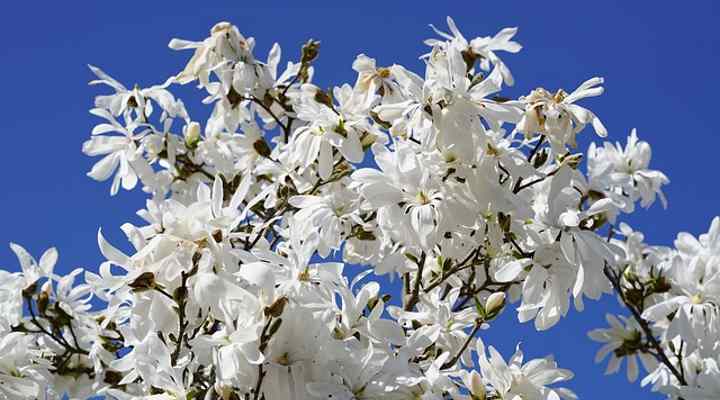
The star magnolia is a small, ornamental tree known for its beautiful, fragrant white flowers. The tree has leaves that are leathery, elliptic, and dark green, which later turn yellow to bronze in the fall. Magnolia trees bloom in early spring, with beautiful white flowers appearing on bare branches. The tree has a slow growth rate, typically reaching heights of 5 to 8 ft. (1.5 – 2.4 m).
The hardy star magnolia tree grows best in full sun and slightly acidic, organically rich soil that is well-draining. Star magnolias are popular specimen plants due to their stunning white blooms and compact size. The star magnolia tree thrives in USDA zones 4 – 9. The tree can be either deciduous or evergreen, depending on the climate.
The tree’s common name, star magnolia, comes from the star-shaped appearance of its white blossoms.
Related reading: How to identify magnolia trees and shrubs.
Mature Size: 5 – 8 ft. (1.5 – 2.4 m)
USDA Hardiness Zones: 4 – 9
Sun: Full sun
Fringe Tree (Chionanthus virginicus)

The small deciduous and hardy fringe tree has white scented flowers
The fringe tree is a small, shrubby tree or known for its clusters of fragrant, creamy-white flowers with long, narrow petals. This low-maintenance, multi-stemmed tree blooms in late spring. After the petals fall in late summer, they create the appearance of a snow blanket draping over the ground. Fringe trees grow between 10 and 20 ft. (3 – 6 m) tall.
Throughout the year, the fringe tree offers abundant visual appeal. Its lance-shaped, glossy green leaves provide summer shade. The tree is covered with stunning snow-white blooms in both spring and summer. In addition, the tree’s gray bark, initially smooth and eventually scaly, adds winter interest.
Fringe trees are ideal for various planting purposes, such as specimen trees, mixed borders, or creating a dramatic focal point. This tree thrives in USDA zones 3 – 9. For optimal growth, plant this tree in moist, well-drained soil.
Mature Size: 10 – 20 ft. (3 – 6 m)
USDA Hardiness Zones: 3 – 9
Sun: Full sun
Flowering Japanese Lilac Tree (Syringa reticulata)
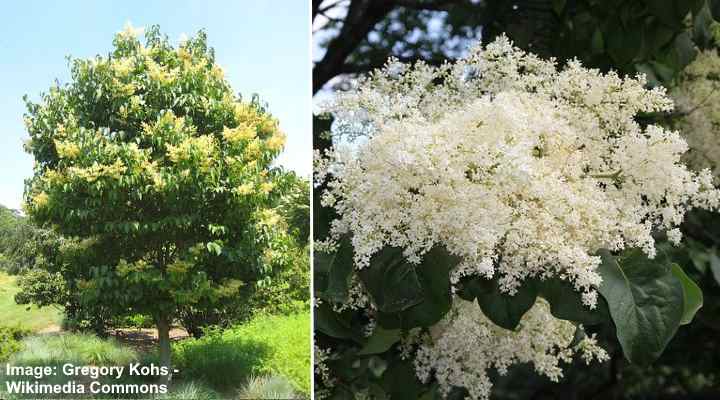
The flowering Japanese lilac is a small tree or large shrub with huge conical blooms of white flowers. The tree also has ovate, dark green leaves and a rounded canopy. The tree’s blooms last for only two weeks, and then give way to yellow seed capsules that persist until winter. Additionally, the reddish-brown bark provides interest in the winter.
The flowering Japanese lilac reaches a maximum height and width of around 20 ft. (6 m). To achieve optimal results, cultivate the Japanese lilac tree in an area that receives full sun to partial shade. Ensure the soil is moist and well-draining, and choose a location with good air circulation.
Mature Size: Around 20 ft. (6 m)
USDA Hardiness Zones: 3 – 7
Sun: Full sun to partial shade
Tea Plant (Camellia sinensis)

The tea plant is a slow-growing, evergreen shrub or small tree recognized for its beautiful white flowers with bright yellow stamens. The tree’s name comes from its fragrant, dark green leaves, which are used to make tea. These attractive plants add elegance to your garden’s shaded areas with their glossy green leaves and beautiful white flowers.
Tea plants thrive in acidic, well-drained, evenly moist soils. They are best suited for temperate climates. These trees are also versatile, allowing them to be grown as specimen plants, in containers, or directly in the ground. In addition, their aromatic flowers attract pollinators such as bees.
Mature Size: 10 to 15 ft. (3 – 4.5 m) tall and 6 to 10 ft. (1.8 – 3 m) wide
USDA Hardiness Zones: 7 to 9
Sun: Partial shade
American Elderberry (Sambucus canadensis)

The American elderberry is a deciduous, woody shrub or small tree known for its delicate clusters of small, fragrant white flowers that bloom in large clusters. The tree blooms during the summer, and then gives way to small, dark berries. The berries are sweet and tart in taste, often enjoyed as a tasty treat.
Native to the United States, American elderberry trees are commonly found in areas such as streams, meadows, moist areas, and stream banks. You can either let this plant grow in its natural shrub form or shape it into a tree. As a shrub, it is an ideal choice for creating a hedge or screen. This tree is a wildlife magnet, with the flowers attracting pollinators and the berries attracting various birds and wildlife.
Mature Size: 5 to 12 ft. (1.5 – 3.7 m) tall and wide
USDA Hardiness Zones: 3 to 9
Sun: Full sun to partial shade
White Flowering Almond Tree (Prunus glandulosa alboplena)
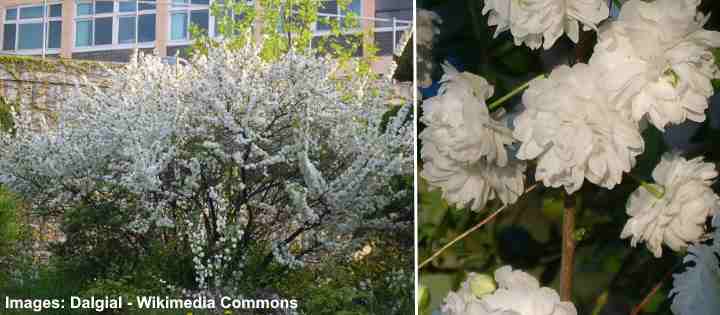
The white flowering almond tree is a shrubby tree characterized by its ornamental white flowers that cover the tree during the spring. These delicate, puffy flowers resemble clouds, creating a beautiful sight. After the flowering period, the tree’s canopy is covered with ovately-shaped, medium-green leaves. The leaves create an attractive, lush backdrop for its captivating flowers.
The white flowering almond tree’s versatility makes it an ideal selection for diverse garden designs. Whether used as a focal point, a charming border tree, or grouped together for a breathtaking visual impact, this tree will enhance your garden’s beauty in numerous ways.
Mature Size: 6 to 8 ft. (1.8 – 2.4 m)
USDA Hardiness Zones: 4 to 8
Sun: Full sun
Angel’s Trumpet (Brugmansia suaveolens)
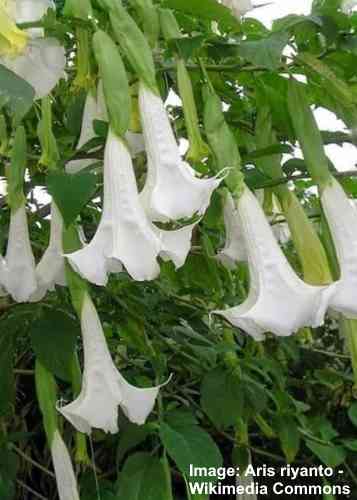
The angel’s trumpet is an evergreen, tropical tree known for its attractive, pendulous white flowers. This tree blooms from summer through fall, bursting into a vibrant display of blossoms. Another identifying feature of this tree is its mid-green leaves which perfectly complement the impressive 12-inch (30 cm) long, creamy-white funnel-shaped flowers.
Native to South America, the angel’s trumpet grows best in humid, tropical climates. For optimal results, plant this tree in fertile, organically rich soil with good drainage. This exotic tropical tree is ideal for enhancing beds and borders, serving as a captivating focal point, or bringing a tropical touch to patios and decks.
All parts of the angel trumpet tree are toxic if ingested, so be careful when planting the tree in areas often visited by children or pets.
Mature Size: 3 to 8 ft. (1 – 2.4 m) tall and 2 to 4 ft. (0.6 – 1 m) wide
USDA Hardiness Zones: 9 to 11
Sun: Full sun or partial shade
Related articles:
